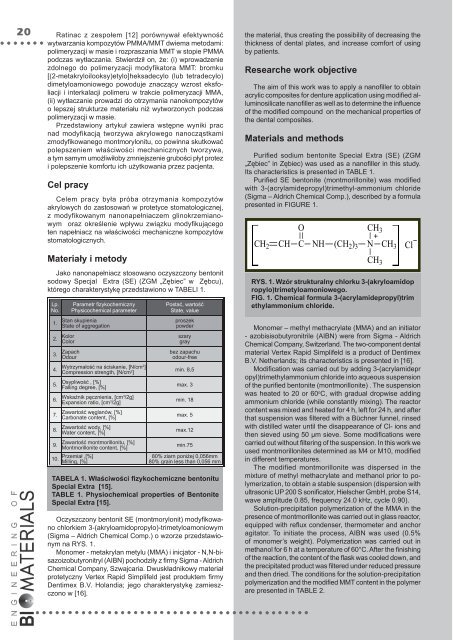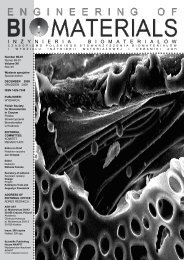62 - Polskie Stowarzyszenie BiomateriaÅów
62 - Polskie Stowarzyszenie BiomateriaÅów
62 - Polskie Stowarzyszenie BiomateriaÅów
You also want an ePaper? Increase the reach of your titles
YUMPU automatically turns print PDFs into web optimized ePapers that Google loves.
20 Ratinac z zespołem [12] porównywał efektywność<br />
wytwarzania kompozytów PMMA/MMT dwiema metodami:<br />
polimeryzacji w masie i rozpraszania MMT w stopie PMMA<br />
podczas wytłaczania. Stwierdził on, że: (i) wprowadzenie<br />
zdolnego do polimeryzacji modyfikatora MMT: bromku<br />
[(2-metakryloilooksy)etylo]heksadecylo (lub tetradecylo)<br />
dimetyloamoniowego powoduje znaczący wzrost eksfoliacji<br />
i interkalacji polimeru w trakcie polimeryzacji MMA,<br />
(ii) wytłaczanie prowadzi do otrzymania nanokompozytów<br />
o lepszej strukturze materiału niż wytworzonych podczas<br />
polimeryzacji w masie.<br />
Przedstawiony artykuł zawiera wstępne wyniki prac<br />
nad modyfikacją tworzywa akrylowego nanocząstkami<br />
zmodyfi kowanego montmorylonitu, co powinna skutkować<br />
polepszeniem właściwości mechanicznych tworzywa,<br />
a tym samym umożliwiłoby zmniejszenie grubości płyt protez<br />
i polepszenie komfortu ich użytkowania przez pacjenta.<br />
Cel pracy<br />
Celem pracy była próba otrzymania kompozytów<br />
akrylowych do zastosowań w protetyce stomatologicznej,<br />
z modyfikowanym nanonapełniaczem glinokrzemianowym<br />
oraz określenie wpływu związku modyfi kującego<br />
ten napełniacz na właściwości mechaniczne kompozytów<br />
stomatologicznych.<br />
Materiały i metody<br />
Jako nanonapełniacz stosowano oczyszczony bentonit<br />
sodowy Specjal Extra (SE) (ZGM „Zębiec” w Zębcu),<br />
którego charakterystykę przedstawiono w TABELI 1.<br />
Lp.<br />
No.<br />
1.<br />
2.<br />
3.<br />
4.<br />
5.<br />
6.<br />
7.<br />
8.<br />
9.<br />
10.<br />
Parametr fi zykochemiczny<br />
Physicochemical parameter<br />
Stan skupienia<br />
State of aggregation<br />
Kolor<br />
Color<br />
Zapach<br />
Odour<br />
Wytrzymałość na ściskanie, [N/cm 2 ]<br />
Compression strength, [N/cm 2 ]<br />
Osypliwość , [%]<br />
Falling degree, [%]<br />
Wskaźnik pęcznienia, [cm 3 /2g]<br />
Expansion ratio, [cm 3 /2g]<br />
Zawartość węglanów, [%]<br />
Carbonate content, [%]<br />
Zawartość wody, [%]<br />
Water content, [%]<br />
Zawartość montmorillonitu, [%]<br />
Montmorillonite content, [%]<br />
Przemiał ,[%]<br />
Milling, [%]<br />
Postać, wartość<br />
State, value<br />
proszek<br />
powder<br />
szary<br />
gray<br />
bez zapachu<br />
odour-free<br />
min. 8,5<br />
max. 3<br />
min. 18<br />
max. 5<br />
max.12<br />
min.75<br />
80% ziarn poniżej 0,056mm<br />
80% grain less than 0,056 mm<br />
TABELA 1. Właściwości fizykochemiczne bentonitu<br />
Special Extra [15].<br />
TABLE 1. Physiochemical properties of Bentonite<br />
Special Extra [15].<br />
Oczyszczony bentonit SE (montmorylonit) modyfikowano<br />
chlorkiem 3-(akryloamidopropylo)-trimetyloamoniowym<br />
(Sigma – Aldrich Chemical Comp.) o wzorze przedstawionym<br />
na RYS. 1.<br />
Monomer - metakrylan metylu (MMA) i inicjator - N,N-bisazoizobutyronitryl<br />
(AIBN) pochodziły z firmy Sigma - Aldrich<br />
Chemical Company, Szwajcaria. Dwuskładnikowy materiał<br />
protetyczny Vertex Rapid Simplifeld jest produktem fi rmy<br />
Dentimex B.V. Holandia; jego charakterystykę zamieszczono<br />
w [16].<br />
the material, thus creating the possibility of decreasing the<br />
thickness of dental plates, and increase comfort of using<br />
by patients.<br />
Researche work objective<br />
The aim of this work was to apply a nanofiller to obtain<br />
acrylic composites for denture application using modified alluminosilicate<br />
nanofiller as well as to determine the influence<br />
of the modifi ed compound on the mechanical properties of<br />
the dental composites.<br />
Materials and methods<br />
Purifi ed sodium bentonite Special Extra (SE) (ZGM<br />
„Zębiec” in Zębiec) was used as a nanofi ller in this study.<br />
Its characteristics is presented in TABLE 1.<br />
Purifi ed SE bentonite (montmorillonite) was modifi ed<br />
with 3-(acrylamidepropyl)trimethyl-ammonium chloride<br />
(Sigma – Aldrich Chemical Comp.), described by a formula<br />
presented in FIGURE 1.<br />
O<br />
CH 2 CH C<br />
CH 3<br />
NH (CH 2 ) 3 N CH 3<br />
CH 3<br />
Cl<br />
RYS. 1. Wzór strukturalny chlorku 3-(akryloamidop<br />
ropylo)trimetyloamoniowego.<br />
FIG. 1. Chemical formula 3-(acrylamidepropyl)trim<br />
ethylammonium chloride.<br />
Monomer – methyl methacrylate (MMA) and an initiator<br />
- azobisisobutyronitrile (AIBN) were from Sigma - Aldrich<br />
Chemical Company, Switzerland. The two-component dental<br />
material Vertex Rapid Simplifeld is a product of Dentimex<br />
B.V. Netherlands; its characteristics is presented in [16].<br />
Modifi cation was carried out by adding 3-(acrylamidepr<br />
opyl)trimethylammonium chloride into aqueous suspension<br />
of the purifi ed bentonite (montmorillonite) . The suspension<br />
was heated to 20 or 60 o C, with gradual dropwise adding<br />
ammonium chloride (while constantly mixing). The reactor<br />
content was mixed and heated for 4 h, left for 24 h, and after<br />
that suspension was fi ltered with a Büchner funnel, rinsed<br />
with distilled water until the disappearance of Cl- ions and<br />
then sieved using 50 μm sieve. Some modifi cations were<br />
carried out without filtering of the suspension. In this work we<br />
used montmorillonites determined as M4 or M10, modifi ed<br />
in different temperatures.<br />
The modified montmorillonite was dispersed in the<br />
mixture of methyl methacrylate and methanol prior to polymerization,<br />
to obtain a stable suspension (dispersion with<br />
ultrasonic UP 200 S sonificator, Hielscher GmbH, probe S14,<br />
wave amplitude 0.85, frequency 24.0 kHz, cycle 0.90).<br />
Solution-precipitation polymerization of the MMA in the<br />
presence of montmorillonite was carried out in glass reactor,<br />
equipped with refl ux condenser, thermometer and anchor<br />
agitator. To initiate the process, AIBN was used (0.5%<br />
of monomer’s weight). Polymerization was carried out in<br />
methanol for 6 h at a temperature of 60°C. After the finishing<br />
of the reaction, the content of the flask was cooled down, and<br />
the precipitated product was filtered under reduced pressure<br />
and then dried. The conditions for the solution-precipitation<br />
polymerization and the modified MMT content in the polymer<br />
are presented in TABLE 2.













